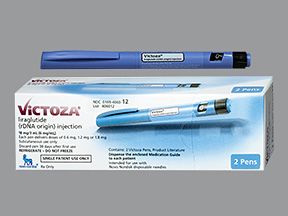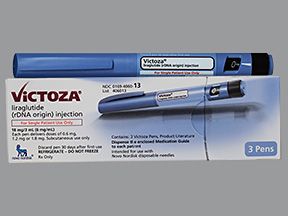Victoza (liraglutide) is a brand-name drug that’s prescribed for type 2 diabetes. Victoza comes in a prefilled pen for subcutaneous injection. It’s typically given once per day. The dosage can vary depending on certain factors.
Victoza is approved by the Food and Drug Administration (FDA) for the following uses:
- To help improve blood sugar levels in people with type 2 diabetes, in combination with a healthy diet and exercise. Victoza may be prescribed for this use in adults and children ages 10 years.
- To reduce the risk of severe cardiovascular (heart and blood vessel) events, such as stroke and heart attack. For this use, Victoza is prescribed for adults who have both type 2 diabetes and cardiovascular disease.
The active drug in Victoza, liraglutide, belongs to a drug class called glucagon-like peptide-1 (GLP-1) agonists.
For information on the dosage of Victoza, including its form, strength, and how to use the drug, keep reading. For a comprehensive look at Victoza, including details about its uses, see this article.
Note: This article describes typical dosages for Victoza provided by the drug’s manufacturer. When using Victoza, always follow the dosage prescribed by your doctor.
Your doctor will prescribe a Victoza dosing schedule that’s best for you. Keep reading for information on Victoza’s typical dosage.
Victoza form
Victoza comes as a liquid solution in prefilled, multidose pens. You or a caregiver will use the pen to deliver the drug as a subcutaneous injection.
A new needle should be inserted into the pen before each injection. You’ll purchase the needles separately from Victoza pens. If necessary, your doctor may provide a prescription for the needles you’ll need.
Victoza strength
Victoza pens come in one strength: 18 milligrams (mg) of the drug in 3 milliliters (mL) of solution. The pen can give Victoza in doses of 0.6 mg, 1.2 mg, and 1.8 mg.
The number of doses you’ll get from each pen will depend on your specific dosage.
Typical dosages for Victoza pen
The dosage of Victoza is the same regardless of why you’re using the drug. Typically, your doctor will start you on a low dosage. Then they’ll adjust it over time to reach the amount that’s right for you. Your doctor will ultimately prescribe the smallest dosage that provides the desired effect.
The following information describes dosages that are commonly used or recommended. However, be sure to take the dosage your doctor prescribes for you. Your doctor will determine the best dosage to fit your needs.
The recommended starting dosage of Victoza is 0.6 mg once per day. It should be injected at about the same time each day.
About 7 days after your first dose, your doctor will likely increase your dose to 1.2 mg once per day.
If necessary, your doctor may increase your dose again after another 7 days. If they do, they’ll increase your dose to 1.8 mg once per day. Your dosage will depend on how well the drug is working for you.
Victoza maximum dosage
Regardless of the condition it’s prescribed to treat, the maximum dosage of Victoza is 1.8 mg once per day.
Long-term use
Victoza is meant to be used as a long-term treatment. If you and your doctor determine that Victoza is safe and effective for you, you’ll likely take it long term.
Children’s dosage
Victoza is approved to help manage type 2 diabetes in children ages 10 years and older.
The recommended Victoza dosage is the same in children as adults: once per day. Your child will likely start at a dosage of 0.6 mg per day. If necessary, their doctor may increase the dosage every 7 days, up to a maximum of 1.8 mg.
For more details, see the “Typical dosages for Victoza pen” section above.
If you have questions about your child’s Victoza dosage, talk with their doctor or pharmacist.
Below are some answers to frequently asked questions about Victoza dosages.
Is there a Victoza dosage for weight loss?
No, because Victoza is not approved by the FDA for weight loss.
However, weight loss is a possible side effect of Victoza. In clinical trials, weight loss was reported with 1.2-mg and 1.8-mg doses of Victoza.
It’s important to note that Victoza contains the active drug liraglutide. Other forms of liraglutide, such as the brand-name drug Saxenda, are approved for weight loss in certain situations. For more information on how Victoza and Saxenda compare, see this article.
If you have questions about managing your weight, talk with your doctor. They can recommend ways to maintain a weight that’s healthy for you. For more information about GLP-1 drugs for weight loss, see this article.
Do older adults need a different Victoza dosage?
No, there aren’t different dosages of Victoza for older adults.
Clinical trials of Victoza included adults ages 65 years and older. Victoza was shown to be as safe and effective in older adults as it was for other people in the study. There aren’t any recommended dosages of Victoza specifically for older adults.
For details about what factors may affect your Victoza dosage, see the “Factors that can affect your dosage” section below. You can also talk with your doctor or pharmacist for more information.
Below are general instructions for Victoza administration. But remember, it’s important to use Victoza according to your doctor or healthcare professional’s dosage instructions.
Victoza comes as a liquid solution in a prefilled, multidose pen. You or a caregiver will use a pen to give the drug as a subcutaneous injection. Before your first dose, a healthcare professional (such as your pharmacist) will show you how to give yourself the injections. If your child is prescribed Victoza, you’ll be shown how to give the injections to them.
A new needle should be inserted into the pen before each injection. Needles are purchased separately from Victoza pens. Your doctor may provide a prescription for the needles you’ll need for Victoza pens.
Victoza is typically given once per day. If possible, you should inject Victoza at the same time every day. Injections can be given under the skin of your abdomen, upper arm, or thigh.
You should use a different injection site for each dose of Victoza. This can help avoid injection site reactions, such as skin discoloration, rash, or pain.
Here are some other important tips to remember about giving doses of Victoza:
- Never inject Victoza into a vein or muscle.
- Avoid giving Victoza injections in areas of skin that are tender, scarred, bruised, or damaged.
- Never mix Victoza and insulin in the same injection or inject these drugs in the same spot. Victoza and insulin injections can be given in the same body area. But do not give the injections too close together. (For example, you could give both injections into your abdomen, but you should use opposite sides of your abdomen.)
- Never share Victoza pens with another person, even if you use a different needle.
The drug’s manufacturer also offers step-by-step instructions for giving Victoza injections on its website.
It’s important that you do not inject more Victoza than your doctor prescribes. For some medications, using more than the recommended amount may lead to harmful effects or overdose.
Symptoms of an overdose
Overdose symptoms of Victoza can include:
- severe nausea
- severe vomiting
- severe hypoglycemia (low blood sugar levels), which, although rare, may be life threatening
If you take more than the recommended amount of Victoza
Call your doctor right away if you believe you’ve taken too much Victoza. Another option is to call America’s Poison Centers at 800-222-1222 or use its online tool. If you have severe symptoms, immediately call 911 or your local emergency number, or go to the nearest emergency room.
If you miss a dose of Victoza, skip the missed dose. The next day, take your next dose at the regular time. Do not “double up” and take two doses to try and make up for the missed dose. This could increase your risk of side effects from Victoza.
If it’s been more than 3 days since your last Victoza dose, talk with your doctor before taking your next dose. They may temporarily lower your dosage to 0.6 mg per day. Then, they’ll slowly increase your dose back to where it was before it was lowered.
This is called a dosage taper. Its purpose is to help decrease your risk of certain side effects from Victoza. (This article has more information about potential side effects of Victoza.)
To help make sure that you don’t miss a dose, try using a medication reminder. This can include setting an alarm or timer on your phone or downloading a reminder app. A kitchen timer can work, too.
The Victoza dosage your doctor prescribes will depend on several factors. These include the severity of your type 2 diabetes and any side effects you may experience.
Other medical conditions you have can also affect your Victoza dosage. For this reason, it’s important to tell your doctor about any medications you’re taking before you start treatment with Victoza.
The dosages in this article are typical dosages provided by the drug manufacturer. If your doctor recommends Victoza for you, they will prescribe the dosage that’s right for you. Always follow the dosage that your doctor prescribes for you.
As with any drug, never change your dosage of Victoza without your doctor’s approval. If you have questions about the dosage of Victoza that’s right for you, talk with your doctor.
Besides learning about dosage, you may want other information about Victoza. These additional articles might be helpful:
- More about Victoza: For information about other aspects of Victoza, refer to this article.
- Side effects: To learn about side effects of Victoza, see this article.
- Drug comparison: To find out how Victoza compares with Saxenda, read this article. To learn how Victoza compares with Ozempic, see this article.
- Cost: If you’d like to learn about Victoza and cost, see this article.
- Details on type 2 diabetes: For details on type 2 diabetes, see our diabetes hub and our list of diabetes articles.
Disclaimer: Medical News Today has made every effort to make certain that all information is factually correct, comprehensive, and up to date. However, this article should not be used as a substitute for the knowledge and expertise of a licensed healthcare professional. You should always consult your doctor or other healthcare professional before taking any medication. The drug information contained herein is subject to change and is not intended to cover all possible uses, directions, precautions, warnings, drug interactions, allergic reactions, or adverse effects. The absence of warnings or other information for a given drug does not indicate that the drug or drug combination is safe, effective, or appropriate for all patients or all specific uses.


